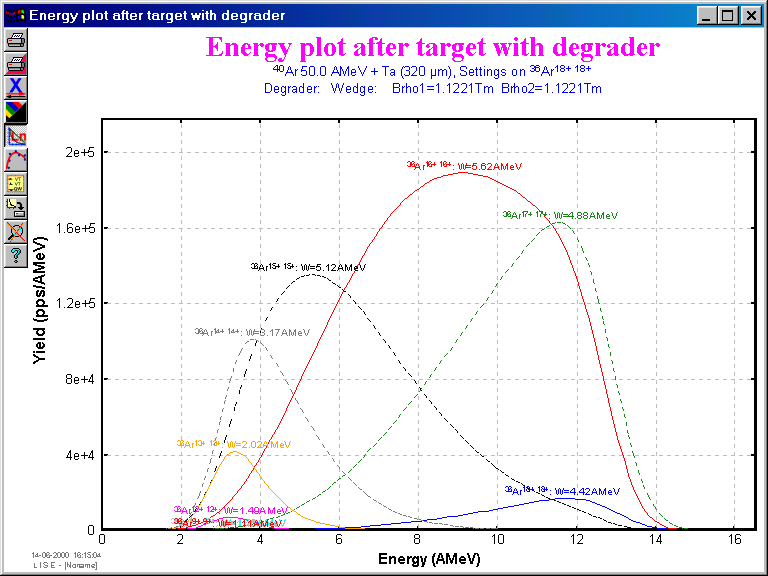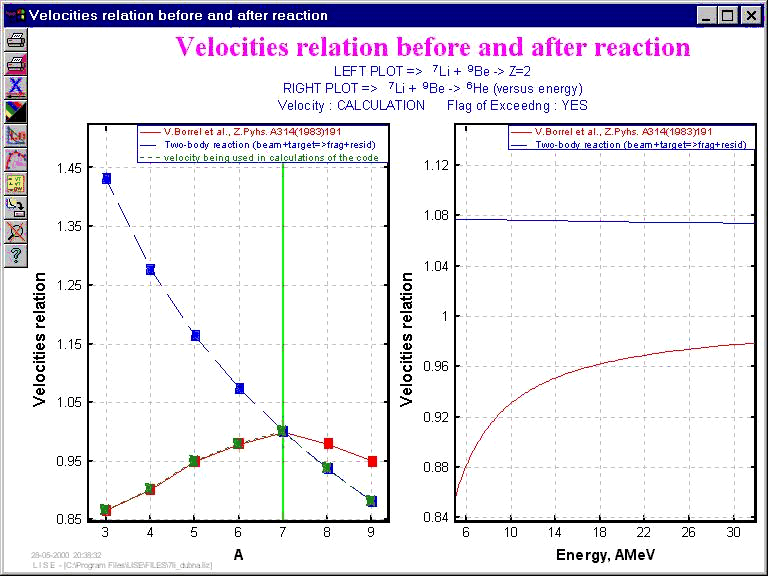
Contents :
1. Degrader after target: contribution
in fragment distributions
2. Charge state distribution in transmission
calculation
3. Development
3.1. M5678-spectrometer's calibration4. Brief description of previous version (4.5.5-4.5.8) changes
3.2. Energy Rest in Physical calculator
3.3. TOF shift
3.4. Note of base configuration used for calculations
3.5. Bug
version 4.5.8
version 4.5.7
version 4.5.6
version 4.5.5
As a result of comparison of the data received in experiment E243a (GANIL), with results of simulation of the LISE program, the divergence was marked in connection with use of a thick degrader after a target. The degrader after a target is used more strongly to strip ions for what after a target with large nuclear number the foil with small Z is used. In the previous versions the program did not expect reactions in an absorber. In the new version of the program the contribution of reactions occurring in a degrader also is taken into account (see Fig.1). For this example were used the Ta-target by thickness of 250 micron and the degrader Be by thickness of 250 micron also, that in mg/cm2 accordingly 415 and 46,2. The contribution from reactions in the degrader it is well visible for in the given figure in consequence of that maxima of distributions on magnetic rigidity are displaced to the right for 36-th argon and to the left for 26-th sodium accordingly.

Fig.1. Magnetic rigidity distributions of fragments 36Ar and 26Na in case of the thick degrader calculated by different versions of the code.
2.Charge state distribution in transmission calculation
In the previous versions of the program the relation of charge states calculated twice after a target (or after a degrader after a target if its thickness is not equal to 0) for average value of energy distribution and after a wedge in the intermediate dispersive focal plane. In other words it was assumed that the relation between charging states was identical in any point of energy distribution that certainly is simplified (see Fig.2). The new version of the program calculates charge states in each of points of energy distribution (see Fig.3). The ratio between charge states is determined from the ratio of energy distribution area given charge state to the sum of all areas.

Fig.2. Energy distributions of 36Ar ions in the reaction 40Ar(50AMeV)+Ta(320m m) calculated by the previous version 4.5 of the code.

Fig.3. Energy distributions of 36Ar ions in the reaction 40Ar(50AMeV)+Ta(320mm) calculated by the new version 4.6 of the code.
M5678-spectrometer's calibration
By analogy to calibrations for the LISE spectrometer the scheme with the buttons was made for the M5678 spectrometer in Dubna, permitting to output dialogues of calibrations of spectrometer dipoles (see Fig.4).

Fig.4
Energy Rest in Physical calculator
In the dialogue " Physical calculator" at the request of users possibility to look values of residual energy in MeV is added. Before the energy was output only in MeV per nucleon.
TOF shift
During experiment a physicist can change a time delay for parameter time of flight, when start (or stop) time of flight takes from high frequency of the accelerator. It is done that interesting fragments was in the middle of time distributions and was not cut off by the following bunch. Similar simulation can be made in the new version changing parameter " Shift TOF" (see Fig.5).

Fig.5. The dialogue "Plot options".
Note of base configuration used for calculations
(see 3.5.1. also "Note of base configuration used for calculations" LISE4_5.doc)
The user can see a mention of the current configuration right after
materials in the window of customizations (see the picture on the right).
Bug
The bug was retrieved in a memory allocation in the previous version of the program in this connection on some computers immediate failure in the program followed.
4. Brief description of previous version (4.5.5-4.5.8) changes
During calculations of transmission and in a mode of a acquisitions for Monte Carlo plots the program allowed to process other processes. Now other processes are not analyzed behind exception button ESCAPE and pressing of a mouse a key STOP accordingly, that has considerably allowed to increase speed of calculations. Switch on/switch off the 3D-balls animation window in a mode of a data set for Monte Carlo to estimate acquisition speed. As shows experience for some computers better to not switch off animation.
The important reminder - values by default in the menu PLOT OPTIONS for options the energetic resolution of detectors, the time resolution of detectors, thickness defect of detectors will be will be applied only after the following loading the program!!! If the program is already started, it is necessary to change these values for detectors directly in their menu.
version 4.5.7
Negative numbers were not entered into versions 4.5.4 on plots of Qgg-systematization and the data from base. Now all works normally.
version 4.5.6
There are considered pick-up reactions. Amendments to cross-sections which recently B.Blank has given, It was made in own way.
version 4.5.5
The tag is entered into the dialogue "Preference", that velocity of a fragment may not exceed its velocity from two-body reaction kinematics. It is very important for pick-up reactions (see the dialogue "Preference" in Fig.6).
The plot of the velocities relation is made. The example is given in Fig.7.

Fig.6. The dialogue "Preferences".

Fig.7. New plot "Velocity relation" .